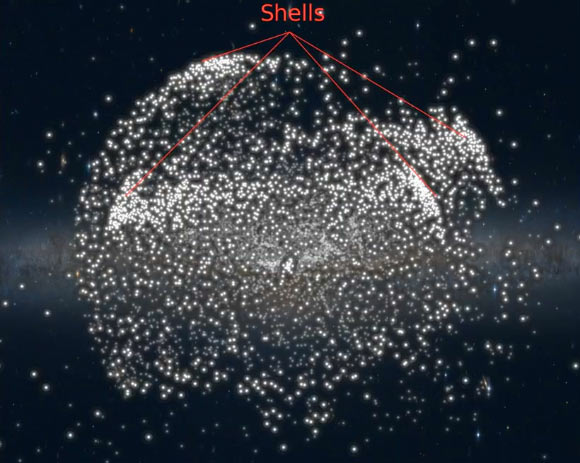A team of astronomers from Rensselaer Polytechnic Institute, the University of Pennsylvania, Flatiron Institute, and Queen’s University has spotted two shells in the Virgo Overdensity region and two shells in the Hercules Aquila Cloud region of the Milky Way. These structures were produced about 3 billion years ago, when a dwarf galaxy plunged into the Milky Way’s center and was ripped apart by the gravitational forces.

Stars identified by Donlon II et al. have formed shell structures in the aftermath of a radial merger occurring 3 billion years ago. Image credit: Rensselaer Polytechnic Institute.
About two decades ago, astronomers identified an unusually high density of stars called the Virgo Overdensity.
Star surveys revealed that some of these stars are moving toward us while others are moving away, which is also unusual, as a cluster of stars would typically travel in concert.
In 2019, Rensselaer Polytechnic Institute’s Professor Heidi Jo Newberg and colleagues proposed that the Virgo Overdensity was the result of a radial merger.
“This group of stars had a whole bunch of different velocities, which was very strange,” Professor Newberg said.
“But now that we see their motion as a whole, we understand why the velocities are different, and why they are moving the way that they are.”
The newly-announced shell structures are planes of stars curved, like umbrellas, left behind as the dwarf galaxy was torn apart, literally bouncing up and down through the center of the Milky Way as it was incorporated into our Galaxy, an event named the Virgo Radial Merger.
Each time the dwarf galaxy stars pass quickly through the Galactic center, slow down as they are pulled back by the Milky Way’s gravity until they stop at their farthest point, and then turn around to crash though the center again, another shell structure is created.
Simulations that match survey data can be used to calculate how many cycles the dwarf galaxy has endured, and therefore, when the original collision occurred.
In the new study, Professor Newberg and co-authors identified two shell structures in the Virgo Overdensity and two in the Hercules Aquila Cloud region, based on data from the Sloan Digital Sky Survey (SDSS), ESA’s Gaia space telescope, and the LAMOST telescope in China.
Computer modeling of the shells and the motion of the stars indicates that the dwarf galaxy first passed through the center of the Milky Way 2.7 billion years ago.
The finding poses potential implications for a number of other stellar phenomena, including the Gaia Sausage, a formation of stars believed to have resulted from the merger of a dwarf galaxy between 8 and 11 billion years ago.
Previous work supported the idea that the Virgo Radial Merger and the Gaia Sausage resulted from the same event.
The much lower age estimate for the Virgo Radial Merger means that either the two are different events or the Gaia Sausage is much younger and could not have caused the creation of the thick disk of the Milky Way, as previously claimed.
A recently discovered spiral pattern in position and velocity data for stars close to the Sun, sometimes called the Gaia Snail, and a proposed event called the Splash, may also be associated with the Virgo Radial Merger.
“There are lots of potential tie-ins to this finding,” Professor Newberg said.
“The Virgo Radial Merger opens the door to greater understanding of other phenomena that we see and don’t fully understand, and that could very well have been affected by something having fallen right through the middle of the Galaxy less than 3 billion years ago.”
The study was published in the Astrophysical Journal.
_____
Thomas Donlon II et al. 2020. The Milky Way’s Shell Structure Reveals the Time of a Radial Collision. ApJ 902, 119; doi: 10.3847/1538-4357/abb5f6







